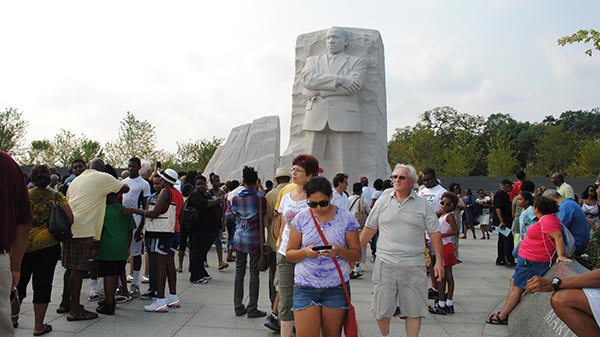
The Dream Lives On: 50th Anniversary of the March on Washington
Slideshow created by Haley Follett: The Signal.
KIMBERLY WARREN
THE SIGNAL
On Aug. 28 we celebrated the 50th Anniversary of the March on Washington – when more than 200,000 people, both black and white, marched side by side from the Washington Monument to the Lincoln Memorial to protest racial discrimination in America.
Life Prior to Aug. 28, 1963, the March on Washington
For nearly a century, the Jim Crow laws in America mandated that black people held a separate but equal status. The status was separate, but hardly equal. Blacks were not allowed to attend school with whites, ride in the front of the bus, or enter into certain public establishments.
The buildings they were allowed in had separate entrances marked with the same “colored” label as the water fountains and restrooms available for use by blacks.
They were not given the right to vote until 1965, when the Voting Rights Act was established.
Racial discrimination was more prevalent and dangerous in the southern states where Emmett Till, a 14-year-old black boy from Chicago, was brutally murdered after speaking to a married white woman.
That was 1955, the same year Rosa Parks’ refusal to sit in back of the bus lead to an arrest that sparked anger among blacks in Alabama. The resulting bus boycott in Montgomery was only one of the many non-violent protests, including boycotts of segregated businesses and lunch counter sit-ins, leading up to the historical March on Washington for Jobs and Freedom.
Ella Mitchell, 95, recalls what it was like as a black child growing up in 1920s Ohio, where discrimination was less intense.
“The schools that I was going to were always mixed,” Mitchell said. “We had no such thing as segregation.”
Although unsegregated, the black and white students did not interact socially.
“White is white; black is black; they tolerated us,” Mitchell said.
Aug. 28, 1963 – March on Washington
The march not only stood for jobs and freedom, but for an end to police brutality and a movement toward integrated schools.
In his now famous “I have a dream” speech, the Rev. Martin Luther King, Jr. said that the signing of the Emancipation Proclamation was meant to end slavery and be the beginning of a new life for blacks. The proclamation should have meant black people no longer had to live a life of bondage.
“But 100 years later, we must face the tragic fact that the Negro is still not free,” King said. “The life of the Negro is still sadly crippled by the manacles of segregation and the chain of discrimination.”
King’s dream included the end of segregation, where everyone would be treated equally. His dream was to see the day when people would be judged by who they are instead of the color of their skin.
“We will be able to speed up that day when all of God’s children, black men and white men, Jews and Gentiles, Protestants and Catholics, will be able to join hands and sing in the words of the old Negro spiritual: free at last! Free at last! Thank God Almighty, we are free at last!,” King said.
Aug. 28, 2013, 50 years after the March on Washington

President Barack Obama is currently serving his second term as President of the United States. In his speech at the 50th anniversary celebration of the March on Washington, Obama talked about the changes that occurred due to the demonstration 50 years ago.
“Those who argued little has changed since the 1960s dishonored the courage and sacrifice of those who lost their lives in the civil rights struggle,” Obama said. “Because they kept marching, America changed. And because they kept marching, eventually the White House changed.”
Much of King’s dream has been realized, but William Hoston, associate professor of Political Science, believes unemployment among blacks is a major setback on the economy.
“We still have a high level of unemployment among the black community, which ranges between 12 and 13 percent and, specifically, among black males; it ranges as high as 20 percent in some major metropolitan areas,” Hoston said. “The mission was to uplift the black community economically and really propel us in a median where we understood that jobs, being employed and promoted would really speak volumes in a greater construct and we’ll be able to be more progressive individuals. We have to restore the commitment of African Americans to be progressive as a whole.”

[…] This year marks the 50th anniversary of the March on Washington. The Signal reporter Haley Follett takes a closer look at what led to the march in 1963 and the changes that have happened throughout the past 50 years. For more information about the 50th anniversary, click here to read The Signal reporter Kimberly Warren’s article “The Dream Lives On.… […]
RT @UHCLTheSignal: The Dream Lives On: 50th Anniversary of the March on Washington: http://t.co/cmcMhLKDxV